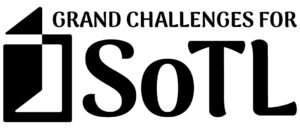GC Home | GC1 | GC2 | GC3 | GC4 | GC5 | GCs in Action | History
Grand Challenge for SoTL #4
SoTL practitioners study postsecondary teaching and learning to better understand and improve how identities affect both teaching and learning. People bring who they are and what they’ve experienced into educational contexts, informing both their own and others’ experiences and interpretations.
What is it?
Identity is one’s internal, subjective, multi-faceted perception of self that is informed by an individual’s ongoing experiences with family, close friends and social groups, the broader society and culture, and more. These experiences are shaped by multiple facets, such as one’s gender, race, socio-economic status, and other demographic characteristics, as well as individual interests and goals. Identity not only shapes one’s sense of self; it also shapes (often unconsciously) how people interpret and respond to information and what is happening to and around them. One’s identity also informs how others interpret and respond to them.
Why and how is this Grand Challenge important?
Teaching and learning are simultaneously individual and social experiences. The role of identity in teaching and learning is important because identity shapes learning through the interactions between educators and students, among students, and between students and what is being learned.
There are many aspects of identity and its influence on teaching and learning that make it a grand challenge worthy of SoTL research. First, understanding identity in any context is challenging because identity itself is internal and multifaceted. Even though some identity characteristics are frequently inferred through observation (e.g. gender, race, age), leading others to make assumptions (see, for example, MacNell, Driscoll and Hunt 2015), as a whole, identity is not directly visible to others, and aspects of identity may even be outside of an individual’s awareness because they are so internalized. As a result, one’s actions and interactions are influenced by identity in ways that they may not recognize.
Understanding identity in teaching and learning, then, is a Grand Challenge for SoTL because each person—educators and students—brings their unique, multifaceted identities into the higher education context, and they interact in dynamic and complex ways. Depending on their own identities, students may feel included or excluded based on a variety of factors related to identity, including the educator’s assumed identity, choices of learning materials and actions, as well as peers’ visible identities and actions (see, for example, Blackburn 2017). At the same time, educators’ sense of efficacy can be affected by how students respond to them, which in turn is affected by both their own and students’ identities. This is further complicated by the fact that, because identity is multifaceted, its impact will vary depending upon which facet is most prominent for each individual within any given context.
These complexities multiply when local and broader cultures are considered, creating another aspect of this grand challenge. In addition to culture influencing an individual’s identity, it influences educator and student perceptions of what learning means and what learning is valued (Chng and Looker 2013). Educational systems themselves are influenced by culture as they are designed based on assumptions about the identities of who is or should be a part of higher education (Chng, Leibowitz, and Mårtensson 2020; Moriña 2017; Tomlinson 2017). These assumptions also influence the location of institutions, the architecture of the classrooms, the required technologies and more, all impacting who feels welcome and able to fully participate based on their identities.
What’s needed to address this Grand Challenge?
In order to improve higher education, there is value in learning more about how we (educators and learners) might become more aware of our identities, how they dynamically impact our interactions, and how they impact teaching and learning. We also need to examine identity-based assumptions to become more inclusive, including the locations and designs of learning spaces and access to other educational resources that may vary based on identity.
How might SoTL practitioners study this Grand Challenge?
| What is? |
|
|
What works? |
|
| What’s possible? |
|
| Conceptual Frameworks |
|
—
References
- Blackburn, Heidi. (2017) The Status of Women in STEM in Higher Education: A Review of the Literature 2007–2017, Science & Technology Libraries, 36:3, 235-273, DOI:10.1080/0194262X.2017.1371658
- Chng, Huang Hoon, Katarina Mårtensson, and Brenda Leibowitz. 2020. “Leading Change from Different Shores: The Challenges of Contextualizing the Scholarship of Teaching and Learning.” Teaching & Learning Inquiry 8 (1): 24-41. https://doi.org/10.20343/teachlearninqu.8.1.3.
- Chng, Huang Hoon, and Peter Looker. 2013. “On the Margins of SoTL Discourse: An Asian Perspective.” Teaching & Learning Inquiry 1 (1): 131-45. https://doi.org/10.20343/teachlearninqu.1.1.131.
- MacNell, Lillian, Adam Driscoll, and Andrea (2015) What’s in a Name: Exposing Gender Bias in Student Ratings of Teaching. Innov High Educ 40, 291–303, https://doi.org/10.1007/s10755-014-9313-4
- Moriña, Anabel. (2017) Inclusive education in higher education: challenges and opportunities, European Journal of Special Needs Education, 32:1, 3-17, DOI:10.1080/08856257.2016.1254964
- Museus, Samuel, Varaxy Yi and and Natasha Saelua (2017). The Impact of Culturally Engaging Campus Environments on Sense of Belonging. The Review of Higher Education, Volume 40, Number 2, Winter 2017, pp. 187-215. https://doi.org/10.1353/rhe.2017.0001
- Tomlinson, Michael. (2017) Student perceptions of themselves as ‘consumers’ of higher education, British Journal of Sociology of Education, 38:4, 450-467, DOI:10.1080/01425692.2015.1113856
Recommended Citation
Scharff, Lauren, Holly Capocchiano, Nancy Chick, Michelle Eady, Jen Friberg, Diana Gregory, Kara Loy, and Trent Maurer. “Grand Challenges for SoTL #4.” International Society for the Scholarship of Teaching and Learning, November 2023. https://issotl.com/grand-challenges-for-sotl/gc-sotl-4/


